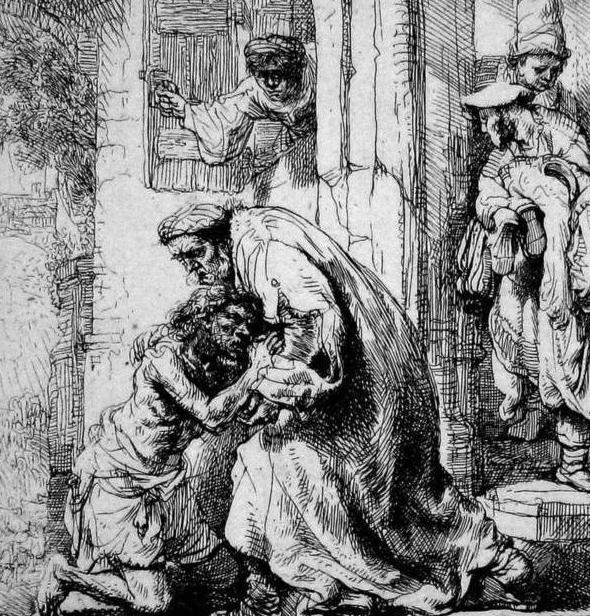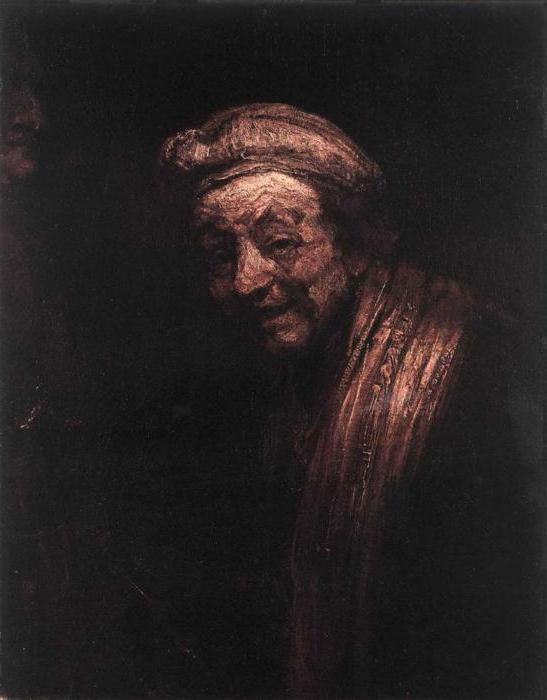The main difference between the work of Rembrandt van Rijn is his timeless character. Historically dating back to the heyday of Dutch painting of the 17th century, it does not allow one to find an explicit link to it either on the topics covered in the paintings or on the artistic means by which he reveals these topics. This property of Rembrandt's painting matures with the course of the life of the master, reaching a maximum towards the end of it.
"The Return of the Prodigal Son" - a picture that is considered to be the will of a brilliant artist. Art historians usually date it to 1663, the year the maestro died. The scale of the philosophical content of this plot, and the picturesque sound of the canvas reach a truly cosmic scale.
Eternal story
He was primarily interested in the depths of human nature, the motives of people's actions. Therefore, it is clear why Rembrandt wrote on biblical subjects much more often than his contemporaries. The parable of the prodigal son is one of the most popular subjects of world painting. “The Return of the Prodigal Son” - a picture that has a separate intrinsic value, but this is also a continuation of the conversation. Jerome Bosch, Albrecht Durer, Murillo and many other masters of different countries and generations had their own interpretations of the parable.

Rembrandt himself turns to this plot more than once - his etchings with the name "Prodigal Son" are known. Discussions on this subject are found by researchers of Rembrandt’s work even in such a famous piece of the master as “Self-portrait with Saskia on her knees” (1635). This is also a kind of “Return of the Prodigal Son” - a picture that is interpreted by them as an illustration of that part of the parable, which tells of the son’s motivation, thoughtlessly spending his father’s inheritance. From this point of view, the joy of life emitted by the master’s canvases, painted in the happiest periods of life, is complemented by a slightly different shade.
The painter is not of life, but of the spirit
The originality of Rembrandt’s creativity is also explained by his purely picturesque techniques, the use of a palette, and work with light and shadow. If the majority of “small Dutch” and artists in tune with them are characterized by a desire for an accurate and tangible depiction of things, an expression of their material essence, then at Rembrandt objects emerge from nonexistence or “from the darkness of the past”, being in close connection with the passage of time, with history. By writing The Return of the Prodigal Son, Rembrandt reaffirmed his loyalty to the special atmosphere inherent only to him, which highlights the main thing on the canvas, not depriving light of a single important detail.

And this is not just a virtuoso game of the “master of chiaroscuro”, as historians and experts on his work call the brilliant Dutchman. This is an extra designation of the primacy for him of the internal content of human actions, the search for their motivating reasons. Where does the essence of man come from, who created it, and how does what determines being change? By the fact that he poses such questions and offers his answers, not related to the time in which he lived, neither internal nor external attributes, Rembrandt shows that he is modern and always relevant.
The Return of the Prodigal Son: Description
His painting style is such a means of creating a narrative, telling stories that none of the artists had at all times. How does Rembrandt tell an ancient parable about returning home?
... We are present during the pause that came after the son stepped up to the threshold of his father’s house. This pause is not soundless - it rings ... After all, too much is lost - his head is shaved, like a convict, his shoes are worn out, he has no strength, no means to achieve anything, not even desires and ambitions. A terrible ending to unfulfilled hopes. Father comes out to meet and simply puts his hands on his son’s shoulders, and he falls, almost dissolving in the folds of his clothes. “The Return of the Prodigal Son” is a picture of the completion of all earthly paths, where at the end there will be a golden ray, similar to that which illuminated those who met, illuminated one of the most prominent Rembrandt images - the father’s head. This ray is the mercy that all the lost should hope for.
Questions and answers
Like his other masterpieces, The Return of the Prodigal Son by Rembrandt endows many mysteries and secrets. Perhaps they appeared simply because of a long temporary detachment, and at the time of writing the picture, it was clear to the audience, for example, who the other characters in the canvas were, why they looked at the visitor in such different ways with such different feelings. Why are the father’s hands lying on his son’s shoulders so dramatically different from each other?
With the remoteness of time, much has been lost, and most secrets have simply lost their meaning. Indeed, is it important, after all, in what kind of relationship are the people present on the canvas? Are their social status or material status important? Now they are all - just witnesses of an exciting event - meetings after a long separation of two native people, witnesses of the act of forgiveness, on which the Christian worldview is largely based.
For all time
Rembrandt van Rijn ... “The Return of the Prodigal Son” is a picture that is almost literally repeated in the finale of Andrei Arsenievich Tarkovsky's famous film “Solaris”, released in 1972.
The images born many centuries before are the most suitable for expressing the feelings that the main character of the film, Chris Kelvin, is experiencing, returning to his native threshold from the star system located millions of kilometers from him ...